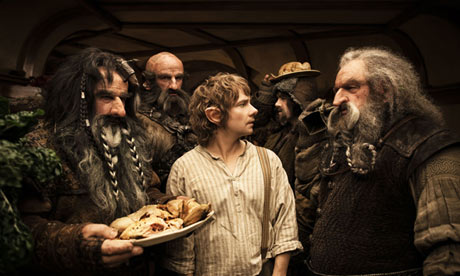After seeing the first part of Peter Jackson’s new “Hobbit” trilogy, which opens everywhere today, it’s easy to see why he filmed its literary successor, “The Lord of The Rings,” first. “LOTR” is simply the better story, at least in cinematic form. Even in just its first incarnation, “The Fellowship of the Ring,” the trilogy presented a journey of such depth and complexity that its status as an art movie as much as a mega-budget blockbuster is no longer in question.
“The Hobbit” has a steeper road to plow. In its much-anticipated first entry, “An Unexpected Journey,” the central quest is far less compelling. Rather than the destruction of a sentient ring that tempts its wearers like a succubus, the plot is predicated on a group of impressively bearded but militarily challenged Dwarves – that old cliché “a ragtag army” fits the bill – attempting to reclaim their decimated homeland long after it was overtaken by a dragon.
The movie attempts to make a case for why I should care about this, but I never really did. Dwarf leader Thorin, as played by Richard Armitage, comes off as such a humorless wet balloon that if he were to be beheaded by the vengeful Pale Orc who killed his father years ago, I would shrug it off as an occupational hazard and wait for the next epic set-piece.
I was much more taken with Martin Freeman’s endearing performance as Bilbo Baggins, the shy Hobbit whom the Wizard Gandalf (Ian McKellen, amiably returning to Middle Earth) insists would be an essential asset in the Dwarves’ quest. Freeman plays Bilbo like the Woody Allen of the Shire – a nebbishy, milquetoast figure who would rather stay at home with his books, doilies and his mother’s cookware than partake in any adventure, unexpected or otherwise. He remains a compelling, real-world conduit into a domain of ever-increasing fantasy.
Clocking at a brisk 169 minutes – practically a short film for Jackson – “The Hobbit” is a movie that throws everything against the wall during the Dwarves’ quest, and most of it sticks. There are lumbering Trolls, psychotic Orcs, giant spiders, Necromancers (or possibly just “conjurers of black magic”), Elves, Wizards (Christopher Lee is back, as Saruman) and Storm Giants, each of whose environments are articulated with the utmost care and detail. The production design, CG or otherwise, is staggering, the set-pieces are visually stunning, and the action is presented with surprises and coherence – though I could do without the numerous “last-minute saves” that cheapen the proceedings like a bad TV thriller.
Jackson, who originally did not want to direct this project, clearly had a lot of fun with the results. His superb handling of the material comes across as one-third George Lucas, one-third Cecil B. De Mille, and one-third Roger Corman. More so than the “LOTR” trilogy, Jackson’s roots as a B-movie maestro are apparent in a few gross-out grace notes, from the presentation of a blubbery, pustule-filled, Jabba the Hut-like Orc to a Dwarf who inhales and exhales flies with every nocturnal breath. The impromptu musical number toward the beginning, in which the Dwarves belt out a rowdy song with Bilbo’s dishware as percussion instruments, is ridiculously enjoyable, and I never wanted it to end.
All of this talent still can’t turn a ho-hum narrative into a monumental story, though. Maybe “The Hobbit” will gain in dramatic potency in its later chapters, but judging by this picture alone, the journey is simply slighter and less substantial than “Lord of the Rings.” It’s telling that the best scene in “The Hobbit” is the one that most conjures “LOTR:” an extended playlet in a dank cave between Bilbo and Gollum (Andy Serkis, who once again deserves a Best Supporting Actor nomination), in which the notorious ring is first introduced. This intimate sequence, virtually free of cutaways to other scenes, is an absolute knockout, plainly staged with characters worth caring about – a beacon, one hopes, for the next two films.

